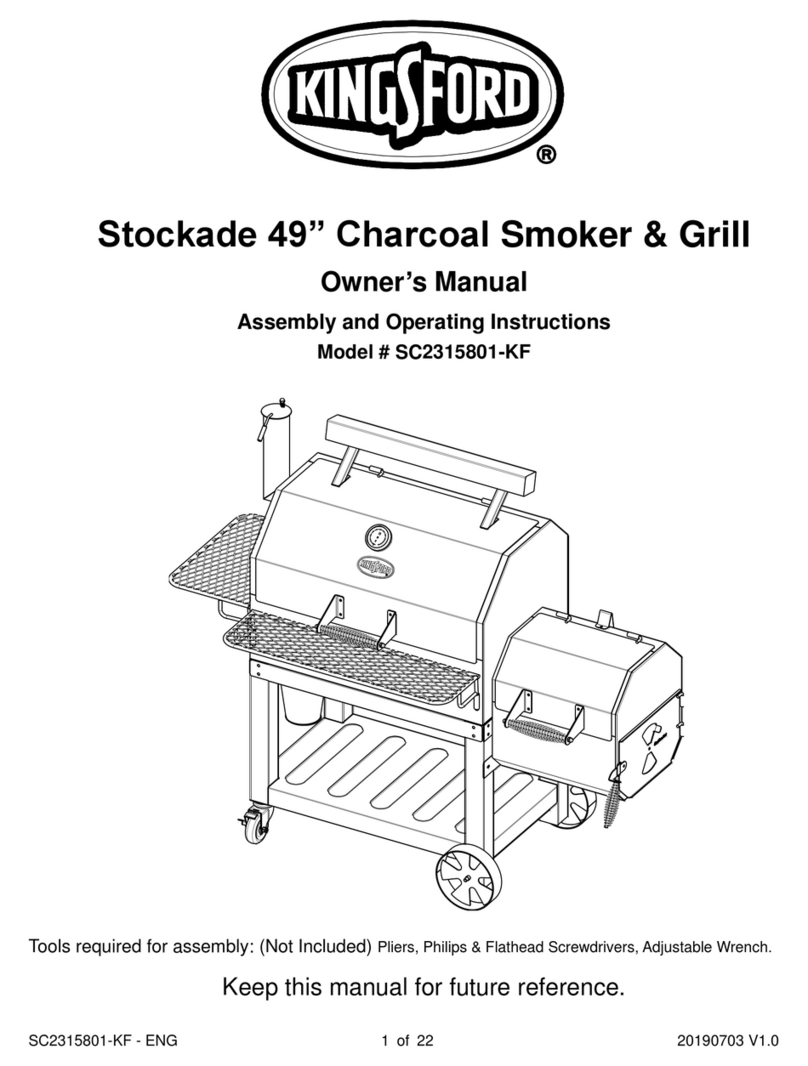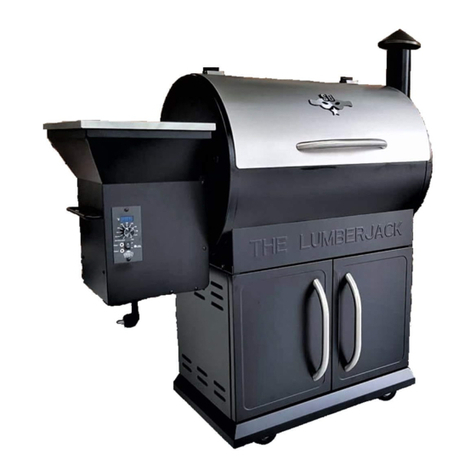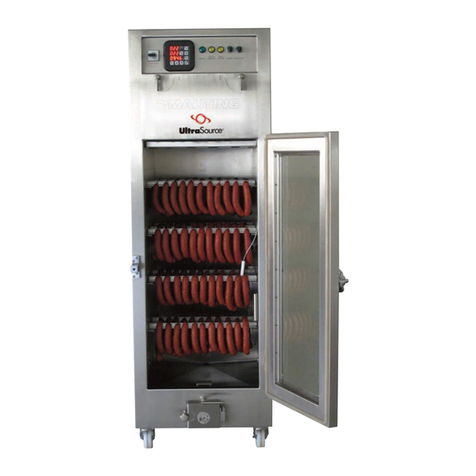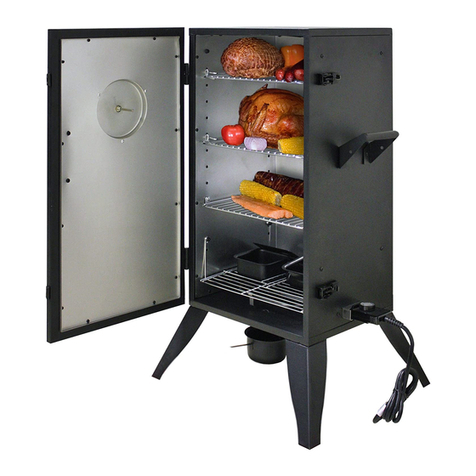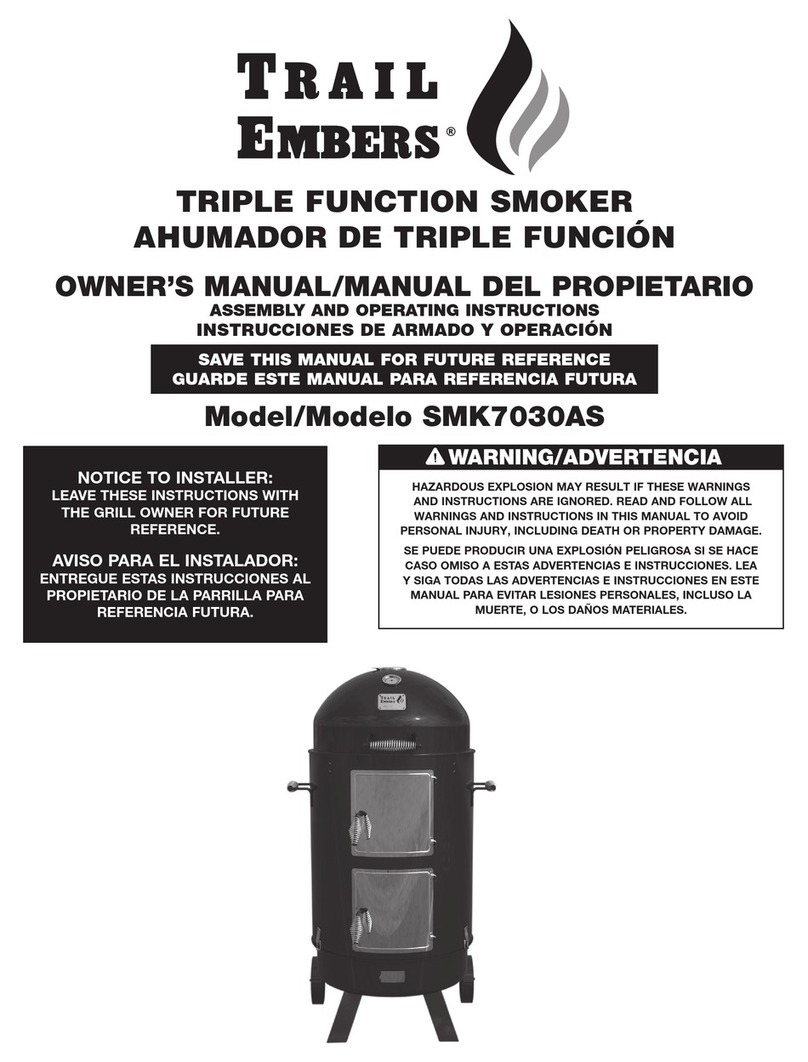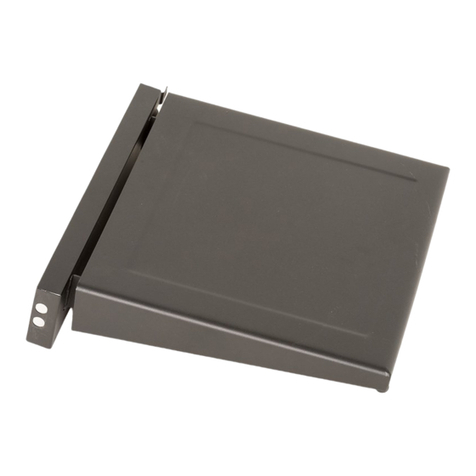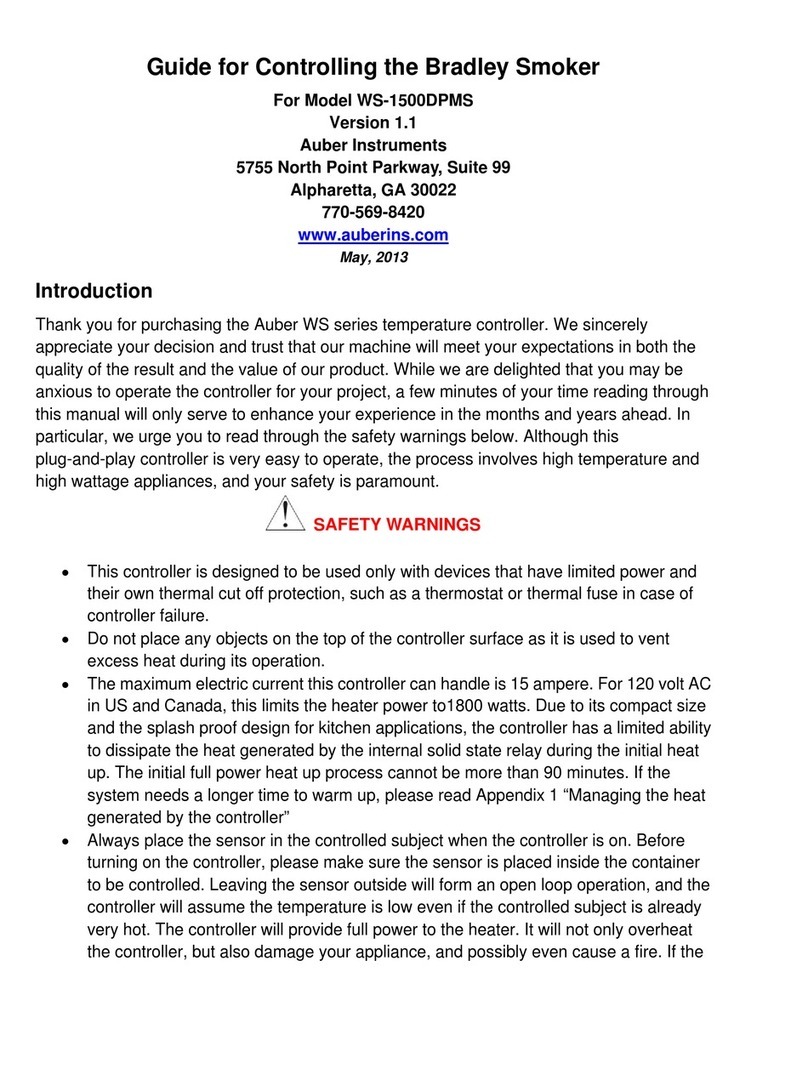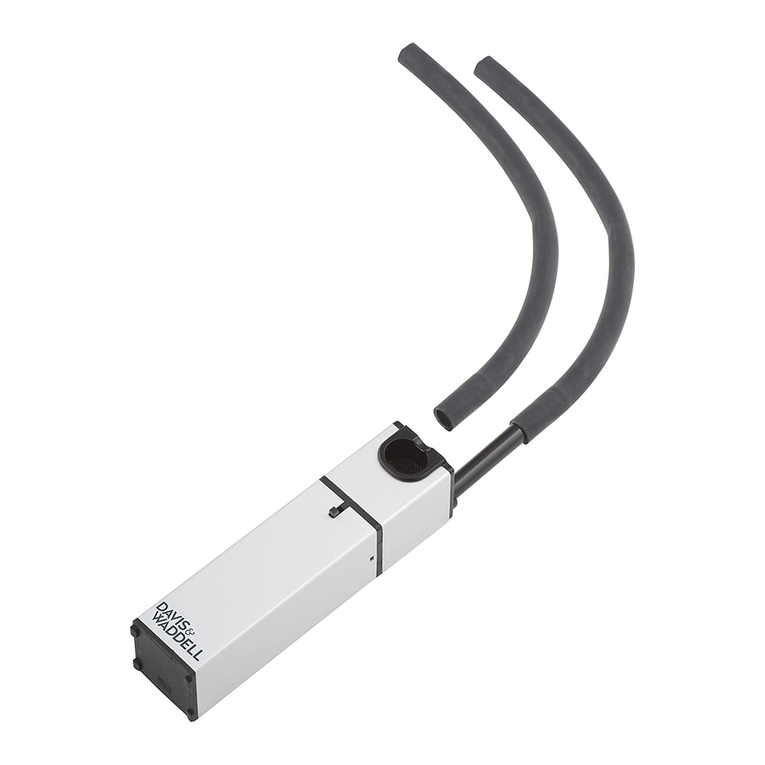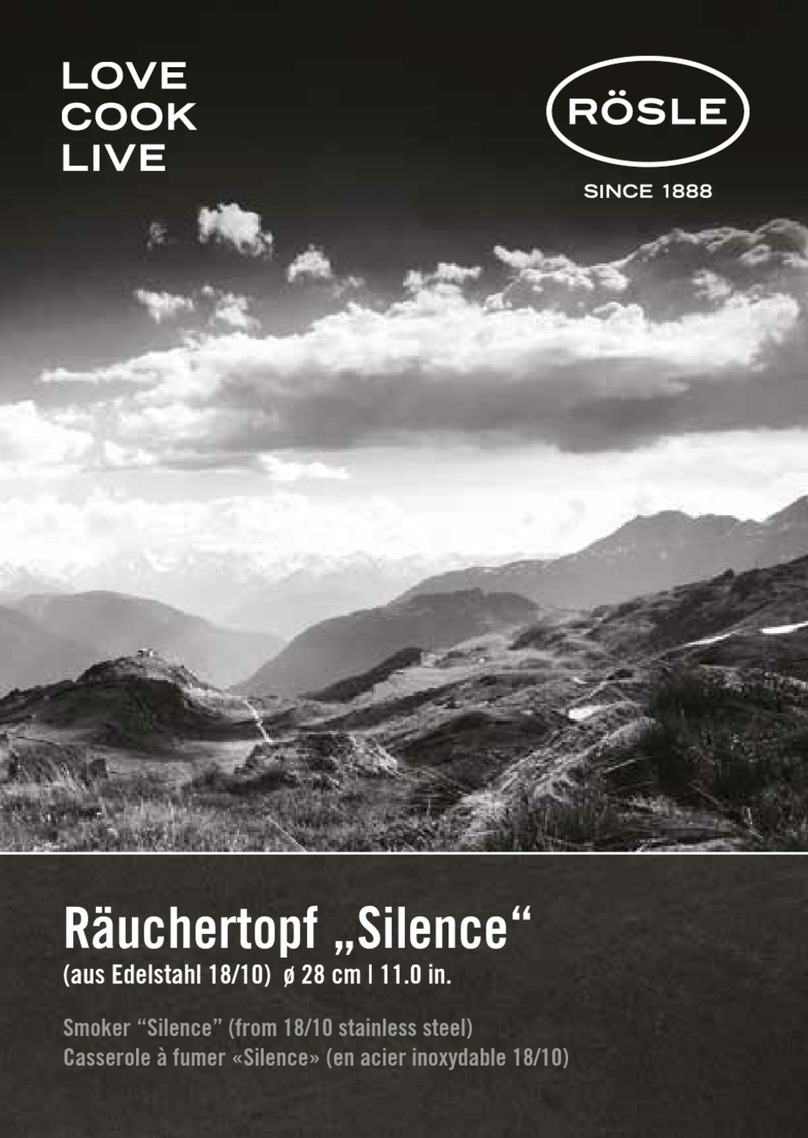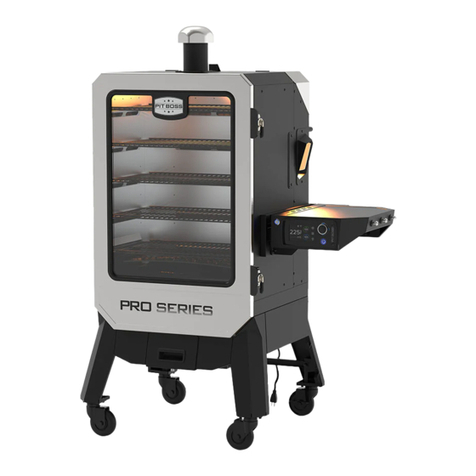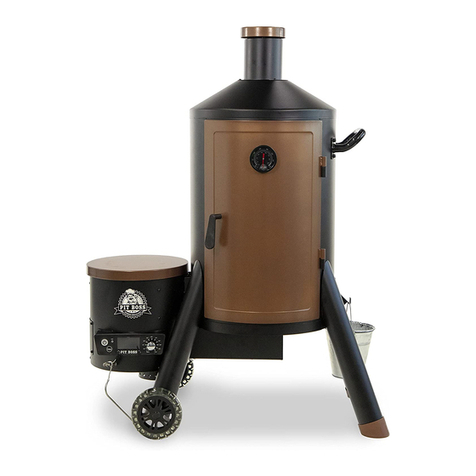
4
każdą listwę. Listwy te stanowią jedynie element dekoracyjny. Daszek możesz przymocować do komory wędzarni za
pomocą zawiasów (16), mocowanych najlepiej w równych odstępach od brzegu komory (ok. 2 cm). Do montażu zawiasów
użyj wkrętów (15). Środkowy otwór w zawiasie pozostaw pusty – w celu uniknięcia rozwarstwienia drewna.
Montaż termometru – zalecamy, by termometr umieścić na drzwiczkach wędzarni. W tym celu wywierć otwór o średnicy fi
8,5 mm, na wysokości ok. 20 cm od zewnętrznego brzegu drzwiczek oraz ok. 20 cm od ich górnego brzegu. W otworku
umieść termometr (10), wkręcając go zgodnie z kierunkiem ruchu wskazówek zegara. Uwaga – nakrętka znajdująca się w
komplecie z termometrem nie będzie potrzebna przy montażu.
3. Montaż paleniska
Rury (2) i (3) połącz ze sobą w taki sposób, aby niemalowany koniec jednej rury dymnej całkowicie wszedł w pomalowany
koniec drugiej rury. Dołącz kolanko (4), nasuwając je na rurę pomalowanym końcem. Niemalowany koniec kolanka umieść
od spodu w otworze znajdującym się w środkowej części podstawy wędzarni (5) – w taki sposób, aby część kolanka
weszła do wnętrza komory wędzarniczej. Drugi koniec połączonych rur dymnych połącz z paleniskiem (1) – niemalowany
koniec rury osadź w otworze paleniska. Palenisko (wyposażone w nóżki) należy dla bezpieczeństwa ustawić na stabilnym,
niepalnym podłożu. Po zmontowaniu wędzarni umieść w jej wnętrzu deflektor (9) – w taki sposób, by znajdował się nad
otworem kanału dymnego. Pomiędzy deflektorem a wylotem kolanka musi pozostać nieco wolnej przestrzeni,
zapewniającej przedostawanie się dymu do komory wędzarniczej. By zabezpieczyć rurę z kolankiem przed ewentualnym
wypadnięciem ze skrzyni wędzarniczej, użyj metalowego prętu (17) – przełóż go przez otworki w kolanku tak, by opierał się
o dno komory i nie kolidował ze stabilnym ustawieniem deflektora.
WAŻNE ZALECENIA I OSTRZEŻENIA DOTYCZĄCE BEZPIECZEŃSTWA
UWAGA! Przed użyciem wędzarni uważnie przeczytaj zawarte w tej instrukcji ostrzeżenia i wskazówki dotyczące
przygotowania wędzarni do pracy oraz jej użytkowania, a następnie postępuj zgodnie z zaleceniami.
OSTRZEŻENIE: Niewłaściwe użytkowanie urządzenia grozi zatruciem, bowiem podczas spalania się drewna emitowany
jest tlenek węgla – gaz lotny szkodliwy dla zdrowia i życia.
Używając wędzarni bezwzględnie przestrzegaj zasad bezpieczeństwa i stosuj się do wymogów dotyczących zapewnienia
odpowiedniej wentylacji podczas całego procesu wędzenia.
To urządzenie jest przeznaczone wyłącznie do użytku na otwartej przestrzeni. Nigdy nie używaj go w
pomieszczeniu.
Wędzarnia musi być ustawiona na płaskiej, równej, stabilnej i niepalnej powierzchni. Zapobiegnie to jej
ewentualnemu wywróceniu się, które może spowodować potencjalne obrażenia ciała lub uszkodzenie mienia.
Nigdy nie stawiaj urządzenia na stole lub blacie.
Nigdy nie stawiaj urządzenia na palnikach gazowych czy elektrycznych, ani też w pobliżu innych źródeł ciepła.
Nigdy nie używaj wędzarni drewnianej jako grzejnika (zobacz ostrzeżenie dotyczące tlenku węgla).
Należy zachować szczególną ostrożność przy przenoszeniu złożonej wędzarni i jej części.
Rozpalanie można rozpocząć dopiero po całkowitym złożeniu wędzarni i dokładnym sprawdzeniu, czy jest gotowa
do użycia.
Nigdy nie używaj urządzenia, które działa nieprawidłowo lub jest uszkodzone.
Rozpalonej wędzarni nie wolno poruszać ani przestawiać.
Zabezpiecz urządzenie przed dostępem dzieci i zwierząt. Nigdy nie pozwalaj obsługiwać wędzarni nieletnim. Kiedy
dzieci i zwierzęta przebywają w pobliżu wędzarni, konieczna jest ciągła kontrola osoby pełnoletniej. Nie
pozostawiaj wędzarni bez nadzoru.
Nigdy nie dopuszczaj do wykonywania innych czynności w pobliżu wędzarni drewnianej, zarówno podczas pracy
urządzenia jak i bezpośrednio po jej użyciu.
Podczas obsługi wędzarni drewnianej zawsze miej pod ręką gaśnicę.
Montażu i obsługi wędzarni nie należy dokonywać po spożyciu alkoholu, a także po zażyciu leków, których
działanie może powodować zaburzenia koncentracji czy równowagi.
Wędzarnia podczas pracy rozgrzewa się i pozostaje ciepła przez pewien czas także po zakończeniu użytkowania.
Zawsze zachowuj ostrożność w pobliżu gorących powierzchni. Przed schowaniem wędzarni upewnij się, że
urządzenie całkowicie ostygło.
Nigdy nie wystawiaj wędzarni na działanie czynników atmosferycznych, które mogłyby niekorzystnie oddziaływać
na materiały, z jakich została wykonana. Przechowuj wędzarnię w suchym miejscu. Temperatura przechowywania
powinna wynosić od 10 do 20°C. UŻYTKOWANIE
UWAGA! Wędzarnię z zewnątrz zalecamy zaimpregnować preparatem na bazie wody lub olejem, np. lnianym.
Przed pierwszym użyciem pustą wędzarnię należy wygrzać w temperaturze ok. 60oC, przez 60 minut.
Wędzarnia przystosowana jest do wędzenia z wykorzystaniem drewna. W celu rozpalenia drewna ułóż jego drobne
kawałki wewnątrz paleniska i roznieć ogień. Następnie warstwowo ułóż większe szczapy drewna w taki sposób, aby zajęły
się ogniem. Cały proces rozpalania wykonuj przy otwartych drzwiczkach paleniska. Po rozpaleniu drewna drzwiczki
paleniska przymknij –pozwoli to odpowiednio zdusić ogień i rozpocznie się generowanie dymu. Poprzez regulację stopnia
zamknięcia drzwiczek możesz regulować stopień zadymienia w wędzarni oraz temperaturę.


